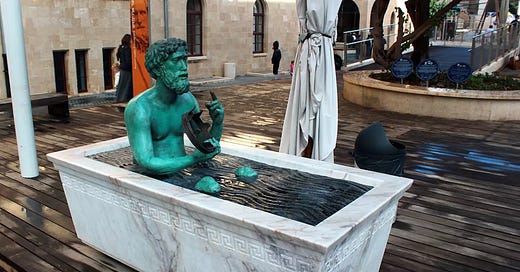Eureka Moments
Tom brings Tudor to his home. There we meet Tom’s wife, Lavinia, and her beautiful sister, Katherine, who is visiting from Savannah. Tom warns Tudor that there isn’t much room for another ice company in these parts. Tudor, who is lying with his head in Katherine’s lap, batting his lashes at her, asks coyly, “Do y’all have many ice companies in Savannah?”
Giggling, blushing, Katherine replies that there are none.
“Well then!” declares Tudor. “We’ll sell our ice in Savannah. We’ll sell our ice where it’s most wanted, in the sultry climes! We’ll sell it in Savannah, and we’ll sell it in Havana, and we’ll sell it in Bombay!”
“ ’At’s an ice idea, boss,” says Tom.Herb ’n’ Lorna, Chapter 3
The eureka effect (also known as the Aha! moment or eureka moment) refers to the common human experience of suddenly understanding a previously incomprehensible problem or concept. Some research describes the Aha! effect (also known as insight or epiphany) as a memory advantage, but conflicting results exist as to where exactly it occurs in the brain, and it is difficult to predict under what circumstances one can predict an Aha! moment.

The most widely known anecdote about Archimedes tells of how he invented a method for determining the volume of an object with an irregular shape. According to Vitruvius, a votive crown for a temple had been made for King Hiero II of Syracuse, who had supplied the pure gold to be used; Archimedes was asked to determine whether some silver had been substituted by the dishonest goldsmith. Archimedes had to solve the problem without damaging the crown, so he could not melt it down into a regularly shaped body in order to calculate its density. In Vitruvius’ account, Archimedes noticed while taking a bath that the level of the water in the tub rose as he got in, and realized that this effect could be used to determine the crown's volume. For practical purposes water is incompressible, so the submerged crown would displace an amount of water equal to its own volume. By dividing the mass of the crown by the volume of water displaced, the density of the crown could be obtained. This density would be lower than that of gold if cheaper and less dense metals had been added. Archimedes then took to the streets naked, so excited by his discovery that he had forgotten to dress, crying “Eureka!” (Greek: “εὕρηκα, heúrēka!,” lit. “I have found [it]!”). The test on the crown was conducted successfully, proving that silver had indeed been mixed in.
The story of the golden crown does not appear anywhere in Archimedes’ known works. The practicality of the method it describes has been called into question due to the extreme accuracy that would be required while measuring the water displacement.
See also: Eureka Moments TG 39
Watching on the treadmill:
CERN: Recreating the Big Bang
From Kanopy: CERN is a self-contained, independent research zone—a parallel universe so to speak. Here the big bang scenario is recreated, searching for the smallest particle. Nikolaus Geyrhalter’s documentary gives an impression of the huge infrastructure which makes an institution like CERN possible. Geyrhalter searches for moments of tension between man and technology. He observes how insight is made, how knowledge originates. Official Selection: Copenhagen International Documentary Film Festival, Rome Docscient Festival, Helsinki Documentary Film Festival
You can watch CERN on Kanopy, using your public library card for access.
[more to come on Thursday, May 12, 2022]
Have you missed an episode or two or several?
You can begin reading at the beginning or you can catch up by visiting the archive or consulting the index to the Topical Guide.
You can listen to the episodes on the Personal History podcast. Begin at the beginning or scroll through the episodes to find what you’ve missed.
You can ensure that you never miss a future issue by getting a free subscription. (You can help support the work by choosing a paid subscription instead.)
At Apple Books you can download free eBooks of “My Mother Takes a Tumble,” “Do Clams Bite?,” “Life on the Bolotomy,” “The Static of the Spheres,” “The Fox and the Clam,” “The Girl with the White Fur Muff,” “Take the Long Way Home,” “Call Me Larry,” and “The Young Tars,” the nine novellas in Little Follies, and Little Follies itself, which will give you all the novellas in one handy package.
You’ll find an overview of the entire work in An Introduction to The Personal History, Adventures, Experiences & Observations of Peter Leroy. It’s a pdf document.





